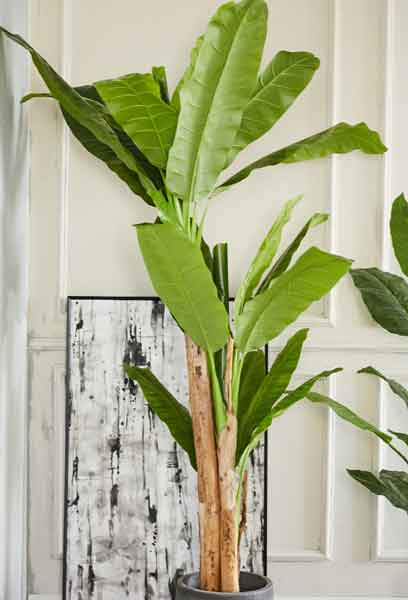Plantain Banana Tree Care & Growing Tips
Written by Iris
Nov 01 2021
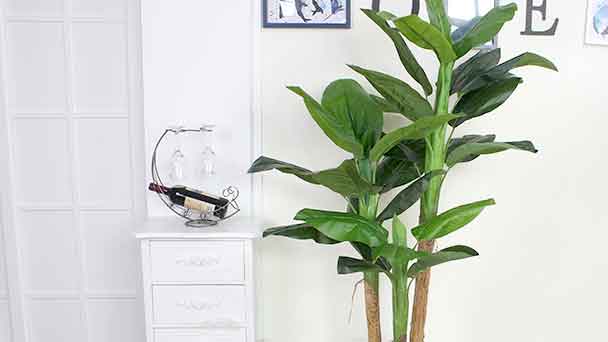
Native to Southeast Asia, Plantain Tree has a cold tolerance zone between 9 and 11. Purple stems of Plantain Banana Tree grow out of the center of the Banana tree like another leaf, but these stems will open into white flowers. Once the Plantain Banana Tree flowers are pollinated, they fade and make room for the fruit to grow. This process can take up to nine months until the fruit is fully developed and ready for harvest.
Sow individually, 1cm (3/8in) deep, in pots of seed compost
Place in a warm location, at a temperature of 21-24ºC (70-75ºF). Germination of fresh seed is quick, but older seed can take up to six months
Gradually move seedlings into more light and increase watering and feeding to encourage growth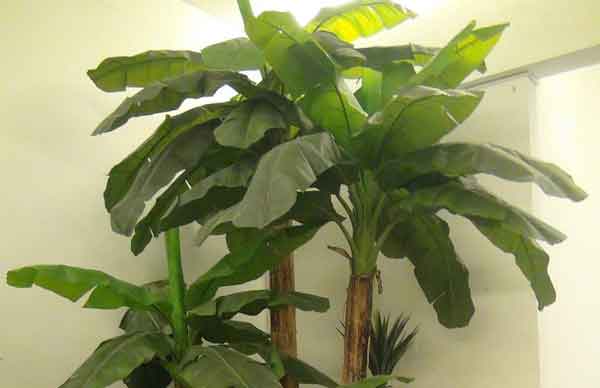
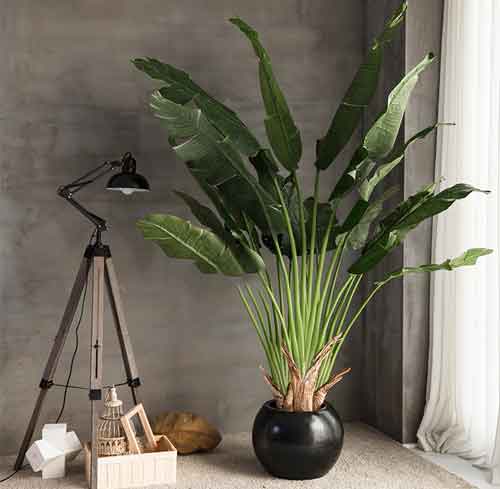
Pruning
Before the banana tree fruits, prune it so there is only one main stem. After it has been growing for six to eight months, leave one sucker (small shoot at the base of the stem). This plant will replace the main stem in the next growing season. After the fruit is removed, cut the main stem down to 2.5 feet. Remove the rest of the stem in a few weeks, leaving the replacement sucker intact.
Aphids: These pests cause curled and shriveled foliage and can also transmit other diseases that will affect any fruit produced.
Black weevils: If you see jelly-like sap oozing from the Banana tree, you may have black weevils that can be eliminated with pesticides.
Nematodes: This is the banana tree's most common pest that will rot the Plantain tree and fruit.
Sap-sucking insects: Mealybugs and red spider mites are also common to Plantain Banana Trees.
Scarring beetle: This pest invades bunches of the Banana tree's fruit and can be eliminated with pesticide.
Thrips: This pest will stain and split the peel of the Banana tree's fruit.
There are many diseases common to PlantainTrees in large orchards and are taken care of with commercial fungicides and pesticides. As for indoor potted Plantain Banana Trees, be on the lookout for root rot, leaf-spot disease, wilt, and powdery mildew.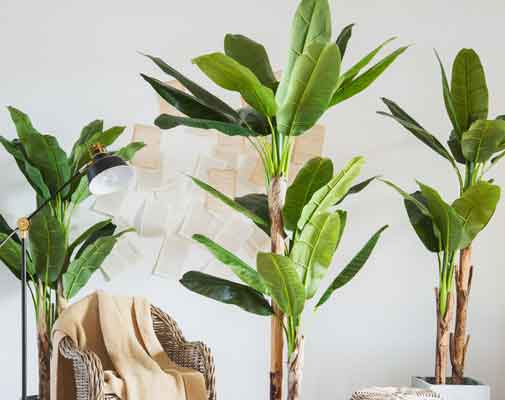
Musa basjoo AGM: Often grown permanently outdoors in sheltered gardens in milder parts of the country, although it has been known to survive in sheltered northerly gardens.
Musa × paradisiaca ‘Rajapuri’: Deep green leaves and may produce edible fruits. Quite hardy and wind-resistant.
Musa sikkimensis: Bronze markings on the young leaves and trunk. The foliage is fairly wind-resistant.
Musa acuminata ‘Dwarf Cavendish’ AGM: Large leaves, sometimes marked red.
Musa acuminata ‘Zebrina’ AGM: Grown for its red-striped foliage. Suitable for container cultivation.
Musa balbisiana: Attractive bluish-green leaves.
Musa itinerans ‘Yunnan’: Slender stems and wide arching, blue-green leaves.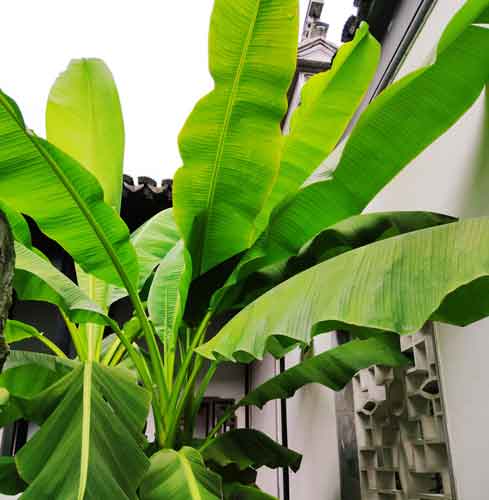
To grow plantain tree successfully you must provide generous amounts of:
Where to Grow Plantain TreeWhen to Grow Plantain TreeHow to Grow Plantain TreeGrow Plantain Tree with SeedsGrow Plantain Tree with CormsGrow Plantain Tree with DivisionHow to Care for Plantain TreePlantain Tree Care - LightPlantain Tree Care - SoilPlantain Tree WateringPlantain Tree Care - Temperature & HumidityPlantain Tree Care - FertilizerPlantain Tree Care - Pests & DiseasesVarieties of Banana TreesPlantain Tree FAQIs It Hard to Grow A Plantain Tree?Is the Plantain Tree a Tree?How Long Does It Take for A Plantain Tree To Make Fruit?
Where to Grow Plantain Tree
Plantain tree is a kind of banana tree. Bananas are considered tropical and sub-tropical plant, however, they can grow in protected micro-climates in warm temperate and even cool temperate zones. For best flowering and fruit development, plant Plantain tree in a position that will receive full sun. In cooler areas try to find a sheltered location near a northerly facing wall. In these climates, growth will all but stop when temperatures drop below around 15°C. Once it warms up again they'll kick back in. Frost will damage leaves but they will reshoot come spring. Note that temperatures below –4°C will likely kill plants. Ideally soil should be open, free-draining, rich and reliably moist however bananas will tolerate virtually any sort of soil except sandy or boggy.When to Grow Plantain Tree
Suckers are planted immediately after field preparation. Plantain Banana Trees can be planted throughout the rainy season. However, they should grow vigorously and without water stress during the first 3 to 4 months after planting. Therefore plantain trees should not be planted during the last months of the rainy season. Planting with the first rains or last rains may be agronomically sound but financially disadvantageous. Most farmers will plant at the onset of the rains, causing the market to be flooded with bunches 9 to 12 months after planting, when prices will be very low. Planting with the last rains will mean more stress for the farmer as he must artificially supply water to the Plantain Banana Trees so as to maintain the optimum soil moisture content and ensure good yield. Hence, planting in the middle of the rainy season is a better proposition as Plantain Banana Trees will then be produced off-season and get high prices.How to Grow Plantain Tree
Grow Plantain Tree with Seeds
File one side of the plantain tree seeds lightly and soak in warm water for 24 hoursSow individually, 1cm (3/8in) deep, in pots of seed compost
Place in a warm location, at a temperature of 21-24ºC (70-75ºF). Germination of fresh seed is quick, but older seed can take up to six months
Gradually move seedlings into more light and increase watering and feeding to encourage growth
Grow Plantain Tree with Corms
Plantain Banana Trees are vegetatively propagated, most often from suckers (shoots that grow from a bud at the base of the Plantain tree) or from corms (underground bulbs known as rhizomes). The use of whole corms is very laborious so it is more common to grow from small pieces of corm. There are three different types of banana suckers which are produced by the mother plant; maidenheads, sword suckers and water suckers. Maidenheads have a large pseudostem which does not produce fruit. Sword suckers have a narrow base, short pseudostem and narrow, blade-like leaves. They produce healthy, fruitful pseudostems when they mature Water suckers have short pseudostems and broad leaves. Water suckers are not strongly attached to the rhizome and generally produce weaker plants and less fruit. Maidenheads and large sword suckers are preferred over water suckers. Planting The desired pieces of the plantain banana tree are usually planted 30–60 cm (11.8–23.6 in) deep in the soil and should generally be planted at the end of the dry season or the beginning of the wet season. Plant spacing is dependent on the cultivar being planted. Frequent weeding is required until plants are tall enough to shade out competing plants and should be started about 6 weeks after planting. Plantain Trees are fast growing and require the frequent addition of nutrients as well as additional irrigation in the dry season.Grow Plantain Tree with Division
Most Musa species produce offsets or suckers, which may develop into fruiting stems under suitable conditions. They may also have to be thinned every few years to prevent crowding in the clump. In spring, dig down to the rhizome and detach the sucker carefully, with as many roots as possible. Remove some of the lower leaves and pot in a container just large enough to take them.
How to Care for Plantain Tree
Plantain Tree Care - Light
Plantain Trees grow in tropical and subtropical parts of the world and therefore they love full sun, heat and humidity. If you’re growing banana tree you should keep it in a spot that receives the sun most of the day but preferably sheltered from the wind.Plantain Tree Care - Soil
Growing Plantain Tree requires well-draining soil, sandy soil that is rich in organic matters and compost. Buy a good quality potting mix for your Plantain banana tree. If you are making it at home make sure to mix sand, perlite, and compost or manure. Banana needs slightly acidic to neutral soil to produce those potassium rich nutritious bananas. The soil pH for plantain trees should be around 6 – 7. If your soil is alkaline mix sulfur to decrease the pH.Plantain Tree Watering
Plantain Trees are tropical and originate in rainforests, so they need a lot of water and plenty of moisture in the air. They do best when planted in groups fairly close together, as this helps to retain moisture in the leaves. Water regularly to make sure the soil stays evenly moist but not soggy. Avoid overwatering plantain trees, which can cause root rot.Plantain Tree Care - Temperature & Humidity
Plantain tree plants love humidity, and you may need to go the extra mile to keep their leaves from getting brown, crispy tips, especially in winter. You can try grouping plantain banana plants together with other humidity-loving tropicals to concentrate the humidity in the air as the Plantain Banana Trees transpire water through their leaves. Another option is to layer a saucer or shallow tray with pebbles, fill the tray with water to just below the top of the pebbles, and then set your plant pot on top of the saucer. As the water evaporates, it will create a cozy pocket of humidity around your Plantain tree plant.
Plantain Tree Care - Fertilizer
Plantain Banana tree is a fast growing plant and it requires heavy feeding to grow at its full strength. Fertilize young plants when it establishes well with nitrogen-rich fertilizer to help them grow faster. Once your Plantain tree in pot becomes mature enough to produce fruit, fertilize it with 15:5:30 fertilizer regularly.Pruning
Before the banana tree fruits, prune it so there is only one main stem. After it has been growing for six to eight months, leave one sucker (small shoot at the base of the stem). This plant will replace the main stem in the next growing season. After the fruit is removed, cut the main stem down to 2.5 feet. Remove the rest of the stem in a few weeks, leaving the replacement sucker intact.
Plantain Tree Care - Pests & Diseases
Owners of Plantain Tree need to stay vigilant of the many pests and diseases that can afflict a banana tree. Pests include the following:Aphids: These pests cause curled and shriveled foliage and can also transmit other diseases that will affect any fruit produced.
Black weevils: If you see jelly-like sap oozing from the Banana tree, you may have black weevils that can be eliminated with pesticides.
Nematodes: This is the banana tree's most common pest that will rot the Plantain tree and fruit.
Sap-sucking insects: Mealybugs and red spider mites are also common to Plantain Banana Trees.
Scarring beetle: This pest invades bunches of the Banana tree's fruit and can be eliminated with pesticide.
Thrips: This pest will stain and split the peel of the Banana tree's fruit.
There are many diseases common to PlantainTrees in large orchards and are taken care of with commercial fungicides and pesticides. As for indoor potted Plantain Banana Trees, be on the lookout for root rot, leaf-spot disease, wilt, and powdery mildew.

Varieties of Banana Trees
Ensete ventricosum AGM: Can be grown outdoors in frost-free areas. Erect, narrowly oblong leaves to 3m in length, with red midrib beneath.Musa basjoo AGM: Often grown permanently outdoors in sheltered gardens in milder parts of the country, although it has been known to survive in sheltered northerly gardens.
Musa × paradisiaca ‘Rajapuri’: Deep green leaves and may produce edible fruits. Quite hardy and wind-resistant.
Musa sikkimensis: Bronze markings on the young leaves and trunk. The foliage is fairly wind-resistant.
Musa acuminata ‘Dwarf Cavendish’ AGM: Large leaves, sometimes marked red.
Musa acuminata ‘Zebrina’ AGM: Grown for its red-striped foliage. Suitable for container cultivation.
Musa balbisiana: Attractive bluish-green leaves.
Musa itinerans ‘Yunnan’: Slender stems and wide arching, blue-green leaves.

Plantain Tree FAQ
Is It Hard to Grow A Plantain Tree?
Surprisingly, these exotic tropical plants have very basic requirements; however, the care you provide must be consistent and ample. Take a little time to learn how to grow plantain tree successfully, make them happy and keep them happy.To grow plantain tree successfully you must provide generous amounts of:
- Organic Matter and Mulch
- Potassium and Nitrogen
- Consistent Warmth
- Consistent Moisture
- Consistent Humidity
- Fertile, Dark, Rich Soil
Is the Plantain Tree a Tree?
Plantain Tree Is Not a Tree. In a scientific sense, the Banana tree is not really a tree. It is a monocot, or a member of the group of plants that include grasses and palm trees. Its trunk is actually called a pseudostem. If you cut the trunk, you can see the overlapping leaves that are layered from within. True trees have an epidermis (bark) and phloem vascular tissues around the circumference. Xylem, or water conducting tissue, is deeper into the trunk towards the pitch core. With Plantain Banana Trees, the xylem and phloem tissue is scattered throughout the pseudostem and there is no epidermis.How Long Does It Take for A Plantain Tree To Make Fruit?
Plantain Banana Trees are usually ready for harvest anywhere from 14 to 20 months depending on the climate and other factors. Flowering usually happens within 10-15 months, while an additional 4-8 months is needed for fruit it develop and ripen. To harvest, simply cut off the entire bunch from the top of the stalk. Use a sharp blade to do this, such as a machete.Latest Updated
- Benefits of Bugleweed - 7 Science-backed Health Benefits
- Bugleweed Dangers & Side Effects - Is It Poisonous?
- How to Plant Evergreen Trees - What You Should Know
- When to Plant Evergreens - Grow Guide for Evergreen Trees
- 12 Wonderful Evergreen Shrubs for Your Garden
- 12 Popular Evergreen Plants with Pictures for Beginners
- When And How To Prune A Lilac Bush Like a Pro
- How to Grow & Care for Lilac Vine (Hardenbergia Violacea)
- Japanese Lilac Tree (Syringa Reticulata) Care & Propagation Guide
- Shumard Oak Pros and Cons - What to Know
Popular Articles
- Winter maintenance of Antirrhinum Majus
- How to Grow Terminalia Mantaly Tree
- How to Grow and Care for Crossostephium Chinense
- How to grow Antirrhinum Majus in spring
- Peristeria Elata (Dove Orchid) Profile: Info & Care Guide
- Underwatered Snake Plant (Sansevieria Trifasciata) - Signs And How To Fix
- How to Care for Brazilian Jasmine Plant (Mandevilla Sanderi)
- How to Grow & Care for Graptopetalum Purple Delight in Summer
- Rosa Chinensis (China Rose): Plant Growing & Care Tips
- How to Care for Baby Sun Rose (Aptenia Cordifolia)
